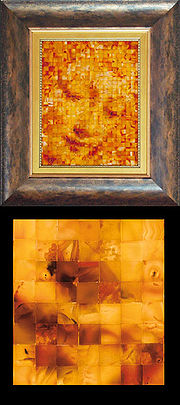
Impressionist mosaics
Encyclopedia

Using stones that are of relatively uniform color and texture (typically pre-cut natural gemstones
Gemstones
Gemstones is the third solo album by Adam Green, released in 2005. The album is characterised by the heavy presence of Wurlitzer piano, whereas its predecessor relied on a string section in its instrumentation.-Track listing:#Gemstones – 2:24...
such as jasper, marble, or amethyst), the resulting mosaics have a uniquely ethereal quality that distinguishes them from traditional processes. Since the technique uses uniformly cut stones, it does not require grouting. The work shown on the right was created by Roy Feinson
Roy Feinson
Roy Feinson is a South African born artist, writer, software engineer, and founder of . He is perhaps best known for creating the genre known as impressionist mosaics, in which the imperfections of natural materials such as turquoise or marble are organized to create ethereal imagery. He is also...
using transluscent carnelian. This particular impressionist mosaic mosaic -- with the image only visible when lit from behind -- is the only known example in existence.
The Process
Impressionist mosaics are created by taking dozens of measurements of every tile in the artist's "palette". The measurements are obtained by digitally photographing each tile and separating it into a grid of sixteen equal sections and analyzing each section for color, contrast and marbling. The resultant data are stored in a databaseDatabase
A database is an organized collection of data for one or more purposes, usually in digital form. The data are typically organized to model relevant aspects of reality , in a way that supports processes requiring this information...
and operated on by proprietary software, which recommends placements for all the tiles. Since the tiles are generally square, the software considers all four possible rotations for each tile, which greatly increases the odds that a given tile will find a good 'home'. Each tile is equivalent to sixteen pixels in the final mosaic since its final location is a function of sixteen sections. While the software is an important component of this process, the artist must still rely on traditional hand-eye techniques to complete the image.
Differences from Traditional Mosaics
Traditional mosaics have a history dating back to at least the fourth century BC, and employ a variety of methodologies to create their images. However, traditional mosaics share the common feature of employing small, uniformly colored materials (tesserae) to create a pattern or picture. Because the tiles can be cut into irregular shapes to conform to the base pattern, mosaisists are able to create works of astonishing detail and color.Alternatively, pixel tile mosaics, such as those found on the floor of the University of Toronto
University of Toronto
The University of Toronto is a public research university in Toronto, Ontario, Canada, situated on the grounds that surround Queen's Park. It was founded by royal charter in 1827 as King's College, the first institution of higher learning in Upper Canada...
pool, employ standard sized tiles (generally 1 x 1 or 2 by 2 inch) in a variety of colors arranged in a uniform matrix. Each tile is a different color and represents a single 'pixel' in the final image. The resulting mosaic is typically coarse and of very low resolution.
History
Pioneering work in this field was conducted in the 1990s by California mosaic artist Roy FeinsonRoy Feinson
Roy Feinson is a South African born artist, writer, software engineer, and founder of . He is perhaps best known for creating the genre known as impressionist mosaics, in which the imperfections of natural materials such as turquoise or marble are organized to create ethereal imagery. He is also...
, who because of its underlying similarities to 19th century impressionism
Impressionism
Impressionism was a 19th-century art movement that originated with a group of Paris-based artists whose independent exhibitions brought them to prominence during the 1870s and 1880s...
coined the term Impressionist Mosaics.
In 2006, mosaic artists Nick Berg and Alan Roth made custom mosaics using this technique commercially available in marble and wood. Because of the increased image resolution inherent in the impressionist mosaic process, they coined the terms High Definition Mosaics and Photo-realistic Mosaics.
External links
- Doubletake Images is the website for Feinson's work
- Exactmosaics is the website for Exactmosaics

